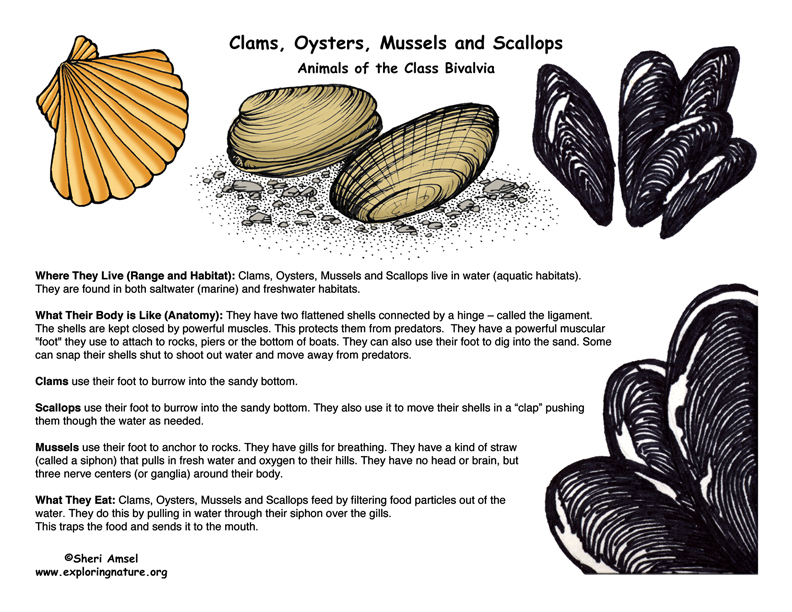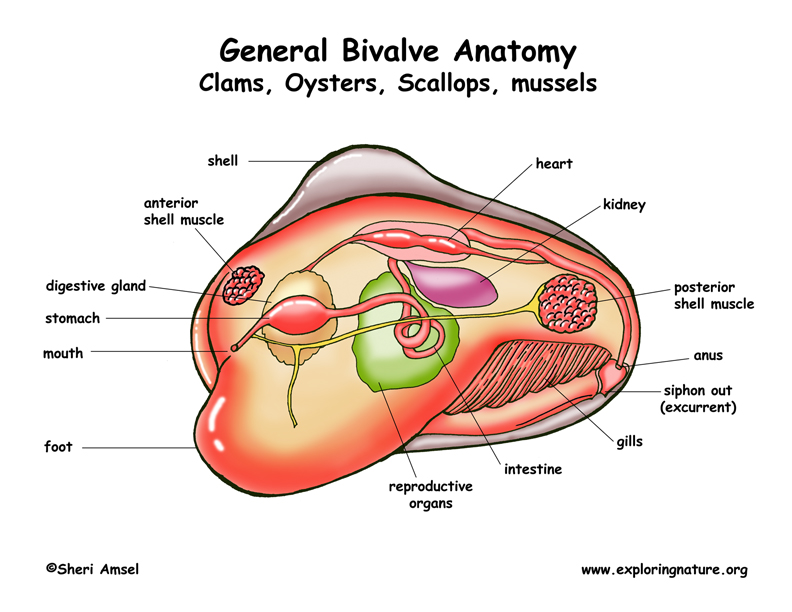

The Bivalves
Bivalves include clams, oytsters, mussels and scallops.
Habitat: Clams, Oysters, Mussels and Scallops live in water (aquatic habitats). They are found in both saltwater (marine) and freshwater habitats.
Physical Traits: They have two flattened shells connected by a hinge – called the ligament, and kept closed by powerful muscles. The shells can open and close when needed, but are usually held closed by powerful muscles to protect them from predators. All use their muscular foot to meet their different lifestyle needs. Clams burrow into the sandy bottom. Scallops burrow or swim freely, using their shell to “clap” water propelling them as needed. Mussels use their foot to anchor to rocks and other objects. They have gills that are bathed with fresh water (and oxygen) through posterior siphons. They have no head, but a diffuse nerve network made up of three nerve centers (or ganglia) distributed around their visceral mass.
Diet: Clams, Oysters, Mussels and Scallops feed by filtering food particles out of the water. Unlike many mollusks that feed using a rasping tongue, called a radula, bivalves feed by filtering. They do this by siphoning water over the gills which traps it and propels it toward the mouth.
Bivalve differences:
Clams use their foot to burrow into the sandy bottom.
Scallops use their foot to burrow into the sandy bottom. They also use it to move their shells in a “clap” pushing them though the water as needed.
Mussels use their foot to anchor to rocks. They have gills for breathing. They have a kind of straw (called a siphon) that pulls in fresh water and oxygen to their hills. They have no head or brain, but three nerve centers (or ganglia) around their body.
To learn more about clams: LINK
To color the parts of a clam: LINK
To label the parts of the clam: LINK
To learn more about mussels: LINK
Try the Invertebrates Matching.
When you research information you must cite the reference. Citing for websites is different from citing from books, magazines and periodicals. The style of citing shown here is from the MLA Style Citations (Modern Language Association).
When citing a WEBSITE the general format is as follows.
Author Last Name, First Name(s). "Title: Subtitle of Part of Web Page, if appropriate." Title: Subtitle: Section of Page if appropriate. Sponsoring/Publishing Agency, If Given. Additional significant descriptive information. Date of Electronic Publication or other Date, such as Last Updated. Day Month Year of access < URL >.
Amsel, Sheri. "Class - Bivalve (Clams, Oysters, Mussels, Scallops)" Exploring Nature Educational Resource ©2005-2025. January 14, 2025
< http://www.exploringnature.org/db/view/Clams-Oysters-Mussels-and-Scallops-Bivalve-Group >


